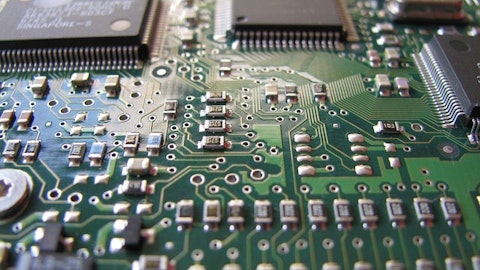Aeva Technologies, Inc. (NYSE:AEVA) Q2 2023 Earnings Call Transcript August 9, 2023
Operator: Good day. My name is Jen, and I will be your conference facilitator. I would like to welcome everyone to Aeva Technologies’ Second Quarter 2023 Earnings Conference Call. [Operator Instructions]. I would now like to turn the call over to Andrew Fung, Director of Investor Relations. Andrew, please go ahead.
Andrew Fung: Thank you, and welcome, everyone, to Aeva’s Second Quarter 2023 Earnings Conference Call. Joining on the call today are Soroush Salehian, Aeva’s Co-Founder and CEO; and Saurabh Sinha, Aeva’s CFO. Ahead of this call, we issued our second quarter 2023 press release and presentation, which we will refer to today and can be found on our Investor Relations website at investors.aeva.com. Please note that on this call, we will be making forward-looking statements based on current expectations and assumptions, which are subject to risks and uncertainties. These statements reflect our views only as of today and should not be relied upon as representative of our views as of any subsequent date. These statements are subject to a variety of risks and uncertainties that could cause actual results to differ materially from expectations.
For a further discussion of the material risks and other important factors that could affect our financial results, please refer to our filings with the SEC, including our most recent Form 10-Q and Form 10-K. In addition, during today’s call, we will discuss non-GAAP financial measures, which we believe are useful as supplemental measures of Aeva’s performance. These non-GAAP measures should be considered in addition to and not as a substitute for or in isolation from GAAP results. The webcast replay of this call will be available on our company website under the Investor Relations link. And with that, let me turn the call over to Soroush.
Soroush Dardashti: Thank you, Andrew, and good afternoon, everyone. Aeva in Q2 continued to make good progress on the path towards commercializing our unique 4D LiDAR-on-Chip technology. I am excited by developments with existing collaborations as well as new opportunities and would like to highlight our key accomplishments, which are summarized on Slide 4. First, our collaboration with a top 10 OEM is going very well. We are deepening our engagements and integrating further into their AV stack. In Q2, we signed a strategic collaboration agreement where Aeva would provide our perception stack as well as jointly work with the OEM on neural network-based machine learning models in order to optimize the OEM’s AV stack and achieve important use cases that previously challenged 3D time-of-flight LiDAR.
In addition, the OEM has decided to expand its on-road deployment with Aeva 4D LiDAR on the back of the milestones we have delivered. Second, I’m happy to share that Aeva secured our first win in rail with Railergy, a leading supplier of railway automation solutions, including to Europe’s largest freight carrier. Aeva’s 4D LiDAR was selected due to our unique velocity data that delivers superior perception capabilities compared to the conventional 3D LiDAR supplier we will replace. And third, we reached critical milestones with our industrial automation partners that keep us on track for a 2024 SOP, including the validation of the LiDAR-on-Chip module for the first industrial product by Nikon and progressing on track with our development milestones with SICK AG.
I would now like to provide more color on our recent business developments, which begin on Slide 6. This past quarter, we significantly deepened our collaboration with a top 10 OEM on a number of fronts. The first is around perception software. We signed a strategic collaboration agreement to provide Aeva’s perception stack built around our unique velocity data to help the OEM safely operate under important use cases. We will also jointly work on neural network-based machine learning models, incorporating data from Aeva’s 4D LiDAR to optimize the performance of the overall AV stack. As mentioned last quarter, Aeva’s FMCW technology successfully enabled a key safety use case for highway driving that this OEM was unable to achieve previously with 3D time-of-flight LiDAR.
Through our ongoing work, we have been able to demonstrate additional ways how FMCW’s advantages over time-of-flight, such as direct velocity measurement and long range without the need to push high optical power enables new levels of perception that can help the OEM more reliably achieve their high standards for performance and safety. To provide an example, by leveraging velocity for every pixel, Aeva’s Ultra Resolution differentiates stationary from dynamic points and brings camera-level resolution that can be up to 20x that of the conventional resolution. As a result, our LiDAR can detect small hazardous objects like a tire fragment at outwards of 50% greater range. And because we can instantly measure the velocity for every pixel, Aeva can more quickly and confidently classify objects as compared to 3D time-of-flight LiDARs that require multiple frames and points to infer velocity.
Perception capability like this is critical to safely operate an application such as highway automation. We’re thrilled that the OEM has decided to further leverage Aeva to accelerate development of perception software to enable its highway speed autonomy use cases. The second is that as we continue to achieve perception and development milestones, the OEM has decided to expand on-road deployment with our LiDAR further into 2024. This includes plans for additional vehicles equipped with Aeva 4D LiDAR that will be used to validate our perception software and overall AV stack in order to bring it to market. Overall, we are very encouraged by our progress with the OEM. Our focus will continue to be on supporting this OEM to achieve the requirements and positioning Aeva to be selected for the production vehicle program.
Moving now to Slide 7, where I would like to share more about our first win in rail. Aeva 4D LiDAR has been selected by Railergy to enable their autonomous train solutions. Notably, we believe Aeva replaces a conventional 3D time-of-flight LiDAR supplier because our velocity data, Ultra Resolution and other benefits of FMCW enable Railergy to accurately and reliably identify obstacles on and around the rails, critical use case requirements that could not be achieved with 3D LiDAR. The first application with Railergy is for the largest freight operator in Europe to automate shunting activity, which is when trains are separated, moved and linked together with new cars. Railergy’s solution is intending to incorporate multiple Aeva LiDARs per locomotive to safely enable these actions autonomously.
We are excited to work with Railergy and see opportunities to broaden deployment to Railergy’s other customers, which include other major rail operators. And as the rail industry and regulators look to bring safer and more efficient transport, we are beginning to explore opportunities for different types of applications with leaders throughout the rail ecosystem, including locomotive OEMs, technology innovators and operators. From our engagements, it is clear that Aeva’s combination of long range, instant velocity and immunity to interference can offer unique advantages for rail automation applications. And we look forward to pursuing these opportunities to bring scaled deployment of 4D LiDAR in rail. Let’s now turn to Slide 8. I am happy to share that we are on track to begin startup production for our industrial automation programs in 2024.
And I would like to provide some color on our recent progress with Nikon. This past quarter, we completed development and validation of our LiDAR-on-Chip module for the first product with Nikon. As previously mentioned, this first product is an industrial metrology solution that enables automated inspection during high-volume manufacturing. It requires micron-level precision, where we will leverage our same core 4D LiDAR chip used for automotive applications, but with different algorithms to achieve ultra-high precision. Due to our unique LiDAR-on-Chip module, we are able to offer these capabilities at a lower cost and a much smaller size compared to the current solution utilized today. With all performance specifications confirmed, this paves the way for us to progress to the next stage, where we will work on the production qualification of our first industrial product together with Nikon ahead of SOP in late 2024.
Switching gears now to the opportunities we’re pursuing, let’s turn to Slide 9. Railergy represents a new win this year and we are making progress on further expanding our number of program wins. In automotive, we continue to advance on large serious production programs with a number of leading vehicle OEMs. Feedback has been consistent and encouraging as more OEMs, including especially ones who have previously selected time-of-flight for initial pilot deployments, are appreciating that Aeva’s differentiated FMCW technology can help safely enable their next-generation, broader-scale deployments. In industrial automation, we have multiple ongoing engagements with large industrial sensing companies to leverage our perception platform for industrial measurement applications.
Our focus as a company remains on programs for large-scale deployments with SOPs in the mid-decade, where each of these opportunities offer significant revenue potential for Aeva, and we continue to expect additional award decisions over the next 6 to 12 months. With that, I’ll turn it over to Saurabh.
Saurabh Sinha: Thank you, Soroush, and good afternoon, everyone. I would like to discuss our Q2 2023 financial results, which are summarized on Slide 11. Revenue for Q2 was $0.7 million on account of continued deliveries of Aeries II to existing and new customers. Non-GAAP operating loss was $31.1 million reflecting our ongoing disciplined and strategic approach to R&D and other operating spend. Gross cash use, which we define as operating cash flow less capital expenditure, was $28.5 million, which primarily consists of use of cash for operating expenses. We finished the quarter with cash, cash equivalents and marketable securities totaling $261.2 million and weighted average shares outstanding was 220.5 million in Q2. In summary, Aeva continues to maintain a solid financial position as we progress on our objectives.
We are very encouraged by the commercial momentum in Q2. And looking ahead, we will continue to execute with a strategic approach to allocate resources and optimize spend to further our existing programs and new opportunities. I will now turn the call back to Soroush for closing remarks.
Soroush Dardashti: Thanks, Saurabh. Halfway into 2023, we have made strong progress on our objectives for the year and I am extremely excited about where we stand at a number of our advanced-stage opportunities. The entire Aeva team is incredibly focused on converting these engagements into additional wins. As I conclude, I want to thank each member of the Aeva team for their ongoing dedication as well as our stakeholders for their continued support. With that, we will now open the line up for questions.
Q&A Session
Follow Aeva Technologies Inc.
Follow Aeva Technologies Inc.
Operator: [Operator Instructions]. And our first question today will come from Antoine Chkaiban with New Street Research.
Antoine Chkaiban: Can you maybe provide more details on the strategic collaboration with the top 10 OEM that you just announced? Any indication on volumes and are there any other LiDAR vendors in the pipeline for that specific project? And maybe also when in 2024 do you expect to expand on the road deployment? And what key milestones do you still need to achieve to get there?
Soroush Dardashti: Yes. Antoine, happy to answer the questions. So first of all, we are very encouraged that OEMs in the automotive space, and especially with this top 10 OEM, are seeing continued value and significance in our perception software, right? So let me first, before I answer the question, how we got here. So first — we first started on the hardware side, delivering Aeries II hardware to this OEM and then integrating in their vehicles. And from there, starting the on-road deployment in the past quarter, mentioned. And then from there, with additional units and additional vehicles built, we continued to hit our milestones for the hardware. And we’ve been able to really address some of the most challenging use cases using our 4D LiDAR technology in which previously, this OEM was having challenges to address with time-of-flight 3D-based LiDAR technology.
Now we are further deepening our relationship into software. And with that, we have signed a strategic collaboration agreement to include Aeva’s perception software, really built around our velocity data, to achieve some of those key driving scenarios that have been quite difficult to achieve in. This includes, for example, driving scenarios at highway speeds. We’re talking here, not 30 to 40 miles per hour, but really highway speed, 60-plus miles per hour. And being able to have the vehicle come to a safe stop, especially in those former cases in which it’s difficult to perhaps detect objects that are small or very low reflectivity on the roadway, such as a tire fragment and such. So that’s, I think, where 4D LiDAR really shines and has been able to provide those capabilities.
And we’re now working with them on neural network-based machine learning models, as I mentioned, to really address some of those former cases that were not really possible before. Looking ahead, as we mentioned, we plan to expand our development fleet with our technology with this OEM into 2024, on the road with multiple vehicles starting in ’24 — beginning of ’24. And in a nutshell, really deepening our engagement with this OEM moves us from hardware into the software stack, which we believe creates a flywheel effect for further embedding Aeva’s perception stack and the velocity data, I think, at the heart of the AV software stack with this OEM, and we’re very encouraged by it.
Antoine Chkaiban: Okay. And maybe as a quick follow-up, can you maybe update us on how scaling capacity and taking costs down is playing out? Have things trended as you expected over the last 90 days?
Soroush Dardashti: Yes, yes, happy to. So we have continued to progress on delivering of our Aeries II product to multiple customers and including, of course, in automotive as well as industrial space. And case in point is really our ability to do that has led us to make meaningful advances in progress with a number of customers. For example, the top 10 OEM, with us being able to get into the software stack and putting this strategic collaboration in place on that front. For example, for us, being able to secure our first win in rail with Railergy, and which we’re pretty excited about as well and others. So I think our ability to continue on deploying Aeries II is obviously critical to our progress with customers across both automotive and industrial applications as well as around some of the metrology applications.
As I mentioned on the call, we have also completed the development milestones for Nikon and our customer for the first target deployment in ’24, SOP in ’24, with the metrology application. So we feel pretty good about that. And obviously, we’re working towards our SOP targets with some of these customers.
Operator: And your next question will come from Colin Rusch with Oppenheimer.
Colin Rusch: With the relationship with Nikon and the ability to pull the time frame forward, can you talk a little bit about how that happened and what elements are going a little bit better than you anticipated?
Soroush Dardashti: Yes, Colin. Happy to answer that. As we have said before, I guess maybe at the beginning of the year, we had planned to find opportunities in which we can pull forward our industrial automation launches. And with Nikon, we have really been able to deliver on milestones on or ahead of timing and really focused on our ability to actually achieve the micron-level precision. That’s one of the unique advantages of FMCW, is that we can tune the software with the same core chip module and LiDAR that we have in automotive, but different — for different applications, different software. Instead of maybe going hundreds of meters of range, we can trade that down to a lower distance, but then achieve ultraprecise accuracy, which gets us to micron-level precision.
We have now completed that. Nikon has completed also their validation and verifying the performance specs and the key metrics that really matter for their industrial metrology manufacturing inspection applications. And they’re pleased with that and that’s allowed them to build further confidence for us to move now to the next phase of industrializing and getting the product ready for late next year. And I think really one of the key reasons for us to be able to do that is because we have been doing this for a while already with our Aeries II product. It’s the same hardware. We have had significant experience in developing and releasing new software functionality and validating that with the key customers. And that’s one of the key factors that’s lead us to be able to do that, as well as our ability to actually produce those modules in the sufficient quantities that Nikon needed to qualify [indiscernible].
Colin Rusch: That’s super helpful. And then with the OEMs, congratulations on continuing to move forward with some of these vehicle OEMs. Certainly seeing some of the other emerging LiDAR providers struggle with actually delivering on some of the road maps. Can you talk a little bit about how your conversations are changing with those OEMs? Because I assume that you’re at the table with most everybody talking about future-proofing some of their platforms. And how tangible some of those programs are getting in terms of the potential to move forward in the sales process for you guys?
Soroush Dardashti: Yes, sure. So look, we are generally quite encouraged, very pleased with the progress we’re making across the automotive space, in addition to industrial. I think as we mentioned, where we also see a lot of interesting development is especially in areas where a number of OEMs in the past have had experience with time-of-flight or 3D LiDAR, and were — for initial deployments. But since engaging with us, seeing some of the key unique selling points and advantages of FMCW and how this is really the next-generation technology that’s coming to market. Then working with us and measuring our capability and absolutely deliver on the milestones, on the requirements over time, these 2, I think, factors have really helped us to be able to make meaningful progress with a number of automotive OEMs in the space.
And I think we’ve always talked about that, with where we believe the industry is headed. And some of that is starting to form shape with the progress that we are making, as is the case in the top 10 OEM; as is the case with Railergy, both of which have had experiences with 3D time-of-flight LiDAR now deciding to really replace and [indiscernible] us with as the technology . So that’s what I can share.
Operator: And your next question comes from Joe Moore with Morgan Stanley.
Joseph Moore: I wonder if you could talk a little bit more about the win with Railergy and particularly when you think about the train market, how big is that? Is it — and I think other opportunities to expand beyond that into other sort of autonomous train efforts?
Soroush Dardashti: Joe, happy to answer that. So first of all, yes, we’re pretty excited about our first win in rail here. Again, this is another example of how unique capabilities FMCW enables scenarios for automation that are currently challenged when you use time-of-flight technology. And this is exciting for us because it’s our first expansion into rail applications, and we’re really starting to see some of the breadth and applications that FMCW can help end customers solve. I can give you some context of the overall opportunity in rail here. So the overall opportunity in rail globally is about over $1 billion in the market opportunity. We’re talking about 100,000 locomotives globally. And of that, it’s about 15,000 locomotives in Europe alone.
And we’re talking about multiple LiDARs per locomotive. So the opportunity with Railergy specifically is really with the first deployment in Europe with the largest European freight carrier, thinking of about 2 to 4 LiDAR per locomotive and ASPs of multiples higher than in automotive. And we’re beginning in 2025 for one of our LiDAR for the rail with Railergy. Separately, we are engaged with some of the leaders in the space. That includes train OEMs; that includes technology providers and some of the [indiscernible] operators that we see potential to expand further in the rail application. And Railergy alone also is working with other major rail operators beyond Europe, due to further solutions and various applications, including in Europe and in the U.S. and other global markets.
Operator: We’ll move next to Suji Desilva with ROTH MKM.
Suji Desilva: Hi, Soroush and Saurabh. So just trying to understand, Soroush, the additional auto customers that could follow this Tier 1 you’re working with, would they — would those engagements take the same form of this in terms of a development engagement and then weaving the software together? Would they have a different shape? And concurrent with that question, the ability of Aeva to handle multiple of these engagements concurrently or kind of focusing resources on one and then have it kind of flow forward sequentially? I’d be curious to understand how it would waterfall from here.
Soroush Dardashti: Yes, Suji, happy to answer that. So look, I think we are here building a framework and a platform in which we plan and intend to deploy in collaboration with multiple OEMs over time, with the focus of creating kind of 1 core product with FMCW hardware technology, but also our approach to software is being in a modular way in which we can build the key software features on top of our hardware in a way that can be qualified with, let’s say, the first OEM, including with this top 10 OEM, but can also be then from there, scaled and deployed across multiple other programs. And that’s something that has always been in front of us, and that’s something that we have here with our [indiscernible] solution. So I think it’s very important to start early on with the vehicle manufacturers so that especially bringing a new technology with automated driving, so that you can ensure timely validation, ensure addressing the core cases and really making sure it works before it comes too close to production, and that’s the example that we have.
And we’re hoping that we can leverage this playbook with other OEMs as well. Of course, each customer is going to be different. Sometimes it may not make sense to provide all the modules of the perception software. But that modular approach, I think, is a critical part of our strategy. To your second part of the question about kind of our ability and resources to support multiple OEMs. Today, we have the sufficient staff to be able to support all the engagements that we have today. As we, of course, go along, we’re continuing to hire and expanding on the team so that we can support some of those key programs on the OEM. But again, our strategy is not to go and spray and pray, across many, many opportunities. We’re focused on a number that is a refined number of opportunities with large scale, that each of which provide meaningful opportunity for us and potential for the company.
And with a focused approach, we think that’s the right way to go about with our first deployment and then from there, we can expand.
Suji Desilva: Okay. Great. My other question is on the industrial auto, the Nikon engagement. I guess start of production sometime calendar ’24. Just curious what the shape of that initial unit ramp might look like or just the size of that opportunity, if you want to talk about it that way, for a run rate. And just competitively, I know there’s other industrial LiDAR vendors out there with high unit run rates already, obviously, a less featured one than yours. So maybe you could talk about the pricing strategy here versus those guys, just to contrast what’s already out there in the market versus what you’re going to bring to market?
Soroush Dardashti: Yes, absolutely. So — so look, first of all, the planned launch is towards late 2024 and then starts with volume and scale up from there. Obviously, industrial, the volume and pricing is quite different than in automotive. But just to give you a sense here, we’re talking about orders of magnitude in terms of differences in our ASP between automotive and what is really feasible here. And marching along, the key factors for us is that we’re using the same core technology that we’re developing already for automotive. So we can use the economies of scale, the same manufacturing line, of course with some customizations and such certain things that may not be needed as, for example, long range and such and different software to allow for that.
But from a development perspective, it’s [Technical Difficulty] years to multiple iterations of our LiDAR-on-Chip module. And because we have been able to innovate everything down to the silicon products module basis, we’re able to achieve such lower costs at an ability to build these for Nikon and also helping reduce the size and the form factor of the end product and provide additional benefits to the end customers. So that’s what I can say there.
Operator: And our next question will come from Richard Shannon with Craig-Hallum.
Richard Shannon: I didn’t get a chance to listen to your prepared remarks, so apologies if I’m overlapping with some previously asked questions. But I think the first one I want to follow up was actually a part of Suji’s question, which is how to think about the size of this opportunity with Nikon specifically. I think the time frame is, I think, is well understood. Obviously, the ASPs are quite a bit higher, but it’s hard to think about what kind of volumes are here. So maybe if you just want to take it up to the TAM or SAM level here and get a sense of a couple of years after this ramps, what kind of opportunity does this offer for Aeva?
Soroush Dardashti: Yes. I think — look, what I can say is maybe I can give you, yes, high-level figures about the business. So Nikon itself is doing about $500 million, $600 million a year of business in the industrial metrology space. There are a lot of leaders in this space. [Technical Difficulty] customers in automotive manufacturing and aerospace and others, customers including BMW, [indiscernible] and others. So we really see opportunity there starting with automotive and expanding further to high-volume manufacturing with that. Obviously, what we’re looking to do is providing a part of the system, right, which is a chip module plus the software. At a high level, if you think about ASPs from — in this space for a full entire solution, we’re talking about $100,000-plus per unit with some of those ASPs in the industrial solution.
Obviously, we take a portion of that check, I won’t comment on specifics, but that should give you some rough sense about opportunity and with scale. And this is just for the industrial metrology applications with high-volume manufacturing. We do see opportunities further from there over time, other applications for potential around general-volume electronics manufacturing and such, wherever you need to actually inspect and be precise about that. That — can’t comment on right now, but that maybe should give you some general guidelines about that.
Richard Shannon: Okay. Fair enough. That’s a reasonable answer. Follow-on question here was kind of more in the industrial space here with SICK. And I think your investor presentation says some, let’s see, you’re progressing on development milestones with them with being on track for 2024. Does that mean you’re expecting to start generating some revenues with them? If that’s not the case, please correct the time frame there. And then what are some of these milestones you have to progress through to get to that point?
Soroush Dardashti: Yes. No, that’s correct. We’re obviously working with them currently on developing [Technical Difficulty] hardware and we do expect from a revenue standpoint, we also continue to scale into ’24. That’s correct. And I think from a milestone standpoint, we have been working closely with SICK AG around ensuring that the performance metrics for the industrial end customers across different configurations. One of the key things there across is we’re working also across software configurations, configurability with SICK, which in industrial differences, there’s multiple different types of customers with — each with different types of requirements. And I think one of the unique advantages for FMCW and Aeva is that we can tune those — the performance of the system with software, and effectively, configurability into the actual system without touching the hardware.
And that’s 1 of the seminal points in which SICK was — eventually decided to work with us after [indiscernible] for this product segment. And so we’re working with them around ensuring to define, validate and qualify those different configurations for some of the lead customers there in the industrial sector. That’s the work that we’re doing for now and later in 2024. And so far, we’re progressing good on that.
Operator: There are no further questions at this time and we will now conclude today’s conference call. Thank you for attending.





